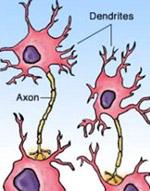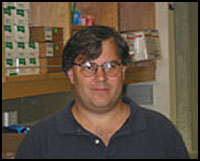| |
If you walk on the beach, chances are you’ll find lots of shells, or at least lots of pieces of what used to be shells. These shells were home and protection to many small sea creatures. Their toughness comes from chitin.
Chitin is made from one of the most abundant bio-molecules on earth, N-acetyl-glucosamine, a form of glucose that is also found in insect exoskeletons as well as part of every cell membrane in your body. From earlier What A Year! stories, you know that glucose is a simple sugar that is essential to human life by providing energy to cells. What interests us here are glucose molecules specifically that are found attached to the proteins that coat the cell membranes. The glucose and protein combination is called a glycoprotein. (You’d think it should be glucoprotein, which is a real word and means the same thing, but glycoprotein won out.)
The Mystery
There can be different combinations of sugars attached to these cell membrane proteins, and their purpose has remained largely a mystery. Now researchers think they might have found an important new clue about their function.
Dr. Michael Demetriou and colleagues of the University of California, Irvine began by looking at the series of steps responsible for the production of the most common glycoproteins. This series of steps is called a pathway. This pathway, known as the N-glycan processing pathway is found in the Golgi complex of all cells. The pathway is made up of many steps, too many to list here, but the end result is the production of a glycoprotein. Dr. Demetriou and his colleagues studied one of the later steps in the pathway, which is controlled by the enzyme named Mgat5. In laboratory mice, they modified the Mgat5 gene, which is responsible for producing the Mgat5 enzyme, so the last step would not happen. Dr. Demetriou found that mice with a modified Mgat5 gene developed spontaneous symptoms very similar to those of multiple sclerosis or MS.
Multiple sclerosis is a neurodegenerative and autoimmune. Neurodegenerative means that neurons in the brain slowly die and can no longer communicate well with each other. Autoimmune means that the body’s immune system sees one part of the body as a foreign invader and tries to rid itself of this foreign particle. Typical foreign particles are things that make you sick such as bacteria and viruses. Researchers believe multiple sclerosis is caused by genetic factors and environmental factors. Let’s see how this fits together.
 |
 |
First, let’s investigate the neurodegenerative aspect of multiple sclerosis. You can think of a neuron as a little ball that then branches into a thousand different directions. The shorter branches are called dendrites and the longer ones are called axons. Neurons communicate with each other by sending electrical impulses from the dendrites and axons of one neuron to another. The dendrites and axons are coated with a myelin sheath that allows the electrical impulses to flow smoothly from one neuron to another. Multiple sclerosis occurs when, for some reason, the myelin sheath is damaged. The electrical impulses can no longer run smoothly. They start to slow down, and so does the entire body of someone affected by the disease. |
The body can heal itself and replace the myelin, but over time, the axons and neurons themselves degenerate. and are permanently lost. The person then progressively worsens and can become paralyzed or incapacitated.
We don’t know what causes the myelin sheath to break down, but studies in mice suggest that it results from a hyperactive immune system. In healthy people, T-cells a form of white blood cells, are vital in fighting off infection. The T-cells of people with MS, however, can be stimulated too easily, which makes them overactive. This may cause the white blood cells in people with MS to mistakenly attack the myelin sheath as if it were a foreign invader.
Dr. Demetriou studied mice with a normal Mgat5 gene and compared these mice to ones that had modified Mgat5 genes. The normal mice did not develop multiple sclerosis. But the mice with the modified Mgat5 gene showed symptoms and signs of multiple sclerosis spontaneously, including loss of myelin and neurodegeneration. This suggests that Mgat5 may be one of the genes responsible for the development of multiple sclerosis. These results led Dr. Demetriou to conclude that glycoproteins have an extremely important role in immune and neuron function and, without them, immune and neurological processes break down.
Eat Right
If mutated Mgat5 promotes multiple sclerosis, then the pathway that makes sugars that are needed for the cell membrane may also be involved in multiple sclerosis. The pathway produces a particular sugar called UDP-GlcNAc using glucose and N-acetylglucosamine (GlcNAc). To determine if these sugars are involved, Dr. Demetriou and his research team treated mouse T-cells with GlcNAc and showed that this increased the activity of Mgat5. More importantly, it suppressed T-cell hyperactivity and their ability to induce multiple sclerosis in mice with deficient Mgat5. He also saw similar effects when he fed mice GlcNAc in their water, which they loved, because it tastes sweet. This treatment was also able to suppress type 1 diabetes in mice, a disease of high blood glucose that also results from overactive T-cells. This work suggests that something in an animal’s diet may change susceptibility to disease. Moreover, replacing these missing sugars kept these animals well. Thus, the environmental factor of choosing your food may have a big impact on your health.
“This is the first demonstration of a mechanism by which metabolism directly influences genetic susceptibility to disease, and may contribute to who develops multiple sclerosis,” says Dr. Demetriou. Dr. Demetriou notes that this work needs to be verified in humans. Indeed his future plans are to investigate this pathway in people. “One day we may be able to identify people with genetic defects in the Mgat5 pathway who are at risk for multiple sclerosis and be able to prevent the development of disease with a simple sugar,” says Dr. Demetriou.
Dr. Michael Demetriou is an Assistant Professor of Neurology at the University of California, Irvine. He was trained as both a research scientist and a medical doctor, receiving his MD and PhD degrees from the University of Toronto, Toronto, Canada. He completed a five-year neurology training program and is a specialist in multiple sclerosis. He has an inquisitive mind and encourages his team to go where the science leads them and to follow their interests. |
|

Dr. Michael Demetriou
Sign Up for our Monthly Announcement!
...or  subscribe to all of our stories! subscribe to all of our stories!

What A Year! is a project of the Massachusetts
Society for Medical Research.
|
|
| |
To Learn More:
- Demetriou M, Granovsky M, Quaggin S, Dennis JW. Negative regulation of T-cell activation and autoimmunity by Mgat5 N-glycosylation. Nature 2001;409:733-739
- Lau KS, Partridge EA, Grigorian A, Silvescu CI, Reinhold VN, Demetriou M, Dennis JW. Cell 2007;129:27-29.
- Grigorian A, Lee SU, Tian W, Chen IJ, Gao G, Mendelsohn R, Dennis JW, Demetriou M. Control of T cell-mediated autoimmunity by metabolite flux to N-glycan biosynthesis. Journal of Biological Chemistry 2007;282:20027-20035.
- Lee SU, Grigorian A, Pawling J, Chen IJ, Gao G, Mozaffar T, McKerlie C, Demetriou M. N-glycan processing deficiency promotes spontaneous inflammatory demyelination and neurodegeneration. Journal of Biological Chemistry 2007;282:33725-33734.
For Information On Multiple Sclerosis:
Rebecca Kranz with Andrea Gwosdow, Ph.D. www.gwosdow.com
HOME | ABOUT | ARCHIVES | TEACHERS | LINKS | CONTACT
All content on this site is © Massachusetts
Society for Medical Research or others. Please read our copyright
statement — it is important.
|
|
|
|

